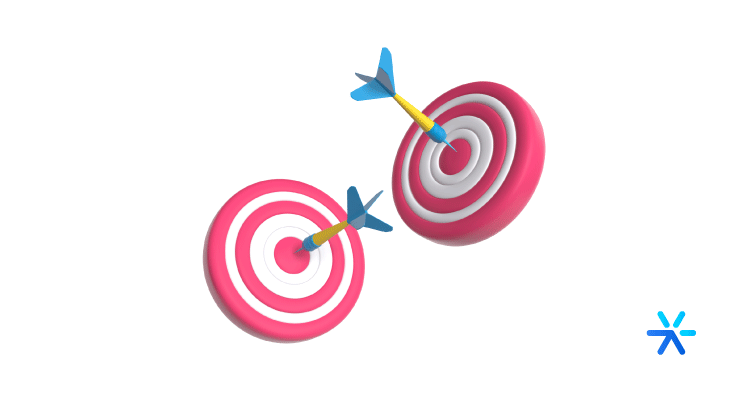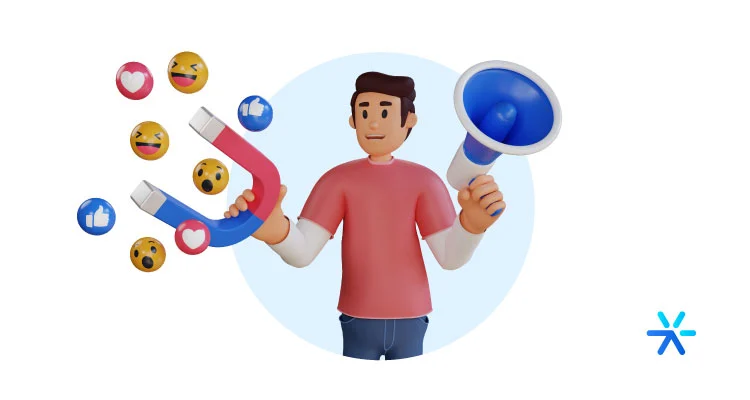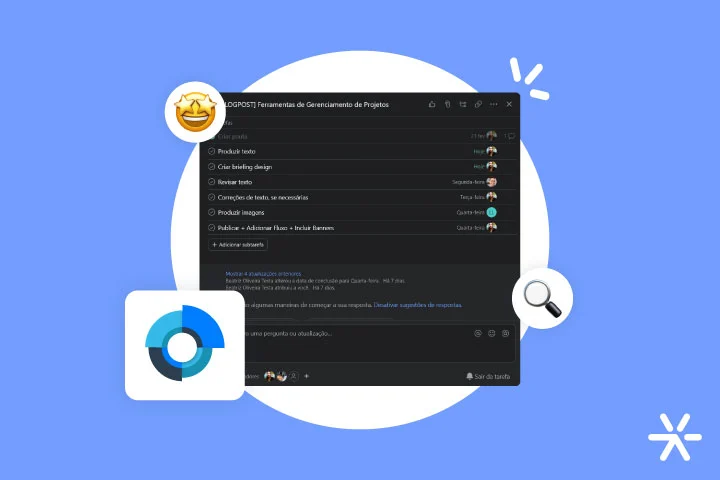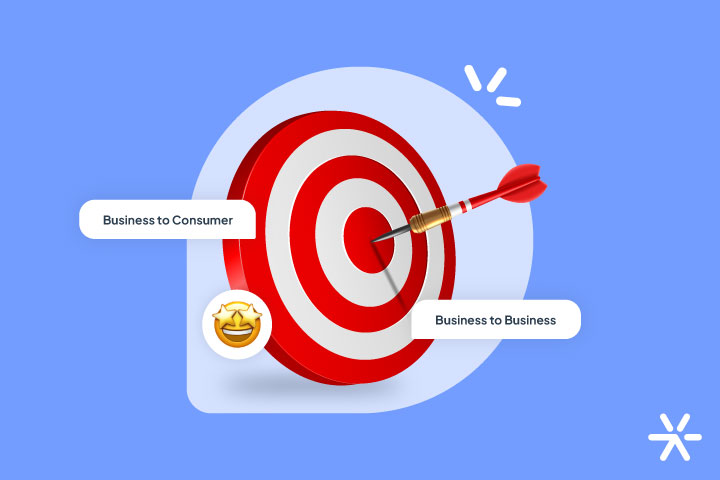How to Identify and Approach Decision Makers in B2B Sales
Especially in the B2B market, the first contact in a commercial approach or a conversion in a material won’t always be directly with the decision-maker.
In business-to-business sales, reaching decision-makers is a challenge faced by almost all sales representatives.
With this in mind, we created this post.
In it, you will better understand the types of decision-makers, how to identify and approach them, what factors influence this dynamic, and how to close a deal in the B2B market.
Let’s get to the article!
What is a Decision-Maker?

In a B2B sales context, decision-makers are the professionals responsible for the final word on a purchase or contract.
The decision-maker considers strategies and financial determinations, as well as the company’s best interest when choosing suppliers.
Who are the Decision-Makers in a Company?
In this type of sale, it’s common to have many people involved.
Especially in larger companies, professionals from different departments often participate in the purchase decision-making process.
Decision-makers are typically employees in higher-ranking positions and can be either from the purchasing department or the department most impacted by the solution or product to be acquired.
For example, in a construction company, decision-makers for purchasing window frames for buildings may be in the purchasing department or the engineering department responsible for the project which requires this type of supply.
In smaller companies or more expensive and complex negotiations, even the company’s CEO may be the decision-maker you need to reach.
Types of Decision-Makers

In addition to identifying who the decision-makers are in a company, it’s also crucial to identify the profile of these professionals.
This is because their profile influences the negotiation dynamics, the priority points when evaluating proposals, and even the preferred communication channels and language.
Here are the four main types of decision-makers:
The Gatekeeper
This professional is prepared to speak with suppliers and sales representatives making the first approach.
They decide whether the conversation will continue and if you will have access to other decision-makers.
The power of this professional is linked to their access to internal company information, contacts in the decision-making flow, and the credibility they hold in this process. Therefore, you must first gain their trust and interest.
The Problem Owner
This professional is the “owner” of the problem or challenge within a company.
This problem, by the way, is what you are trying to solve with your solution.
Since they are dealing with this challenge daily, they have less time to interact with the sales representative, but they also have the most urgency for the purchase, even if they don’t realize it yet.
Access now: Customer Pain Points: 20 Questions to Identify and Tips to Solve
The Budget Owner
As you can imagine, the budget decision-maker is the one who controls expenses and investments.
In many cases, the problem owner needs the budget owner’s approval to proceed with the commercial negotiation.
This profile prioritizes the budget being allocated to the best cost-benefit option and often won’t be attracted by the technical benefits or advantages of a product or service.
Influencers
In many commercial negotiations, you’ll deal with multiple decision-maker profiles, and you may also need to engage with influencers.
This profile has no authority or autonomy to make purchasing decisions, but their opinions influence the actual decision-maker.
In other cases, influencers may also be in the gatekeeper position, meaning their opinion of your solution or product directly impacts whether the presentation moves forward to other decision-makers.
How to Identify and Approach Decision-Makers in B2B Sales?

First, consider the company’s size and how strategic decisions are distributed.
For example, in a smaller company, you may be targeting the CEO.
The second point to consider is the structure and the sector you aim to reach.
Let’s say you’re selling a sales software, a CRM.
You’ll need to investigate the roles and hierarchies in the department of the company you want to sell to, who holds those positions, who is most affected by the lack of your solution…
And all this involves a few steps and tips that we’ll cover.
Titles Can be Deceiving
It’s common for sellers to associate job titles with decision-making power in a commercial negotiation.
They may, as in the previous example, try to reach the sales manager or director.
But reality isn’t always that simple.
A title isn’t necessarily tied to decision-making power, as other factors need to be considered, such as the company’s size, the type of structure used, whether there’s a purchasing department, the type of solution you’re selling, and the influencers’ power.
Essential Steps to Identify the Right Person
To identify the decision-maker you should approach in each situation, follow these steps:
Know each client/company profile
Gather as much information as possible about your prospect.
This will help you understand the negotiation dynamics.
It’s worth investigating other contracts they’ve made, talking to partners from other departments who may know the company’s structure or someone who works there, comparing previous sales made by your company to similar businesses, etc.
Determine your Value Proposition (USP)
Your Unique Selling Proposition is the main promise delivered by your solution.
For any commercial approach, this Value Proposition should be a clear statement offering relevance, benefit, and differentiation.
This is the main reason why the prospect should buy from you, and without it, no prospect will feel the desire to engage.
Learn more: Value Proposition Canvas – What it is and How to Create Yours
Create a detailed persona
Your brand’s persona is a fictional representation of your ideal customer, based on research and data, which helps you understand how each target audience behaves and consumes.
By defining all persona characteristics, you can understand and prioritize what to present and the challenges they face, habits, goals, frustrations, etc.
All of this helps in the sales process.
Read also: Brand Persona and Buyer Persona: Differences and How to Develop Each One
How to Contact Decision-Makers in a Company?
After identifying the decision-makers, the influencing factors and professionals, and understanding what matters to them, it’s time to make the first contact.
Here are some tips:
Use LinkedInLinkedIn
Is an excellent tool for researching, identifying professionals, and making a subtle contact.
It’s also a good option when you don’t have direct contact, such as a phone number or email, and many professionals use it for updates and communication.
Use your Connections
If you already have direct contact with the decision-makers, you can go that route.
But another option is to use connections like contacts from other departments within the same company or even from other supplier companies of your prospect.
Search for Titles (but don’t rely Solely on That)
As mentioned earlier, this shouldn’t be the only factor in finding decision-makers, but if you have no connection, it can be a viable path.
Explore the titles to reach influencers, who may provide the connection you don’t yet have.
Make a Call
It may seem old-fashioned, but the phone is still a useful resource for B2B prospecting.
You may not get direct contact with the decision-maker, but the call can help you understand who they are and what role they occupy.
Work to build Relationships with Gatekeepers
Many decision-makers (especially those in higher positions and larger companies) may have secretaries or assistants who control communication channels with their superiors, like phone and email.
So, keep in mind that you won’t just need to “get past” these gatekeepers, but actually build a relationship and a good image with them.
This way, you’ll not only get direct contact with decision-makers but also have an ally.

Qualification Questions to Identify the Decision-Maker

We have selected some questions that can help identify who the decision-makers are for your sales situation.
Some examples are:
- Who is the end user of this type of product/service?
- Who else is involved in this decision-making process?
- What kind of criteria do you consider for a purchase like this?
- How does the purchasing process work in the company?
- What needs to happen for the purchase to be approved?
- Can you help me present this proposal to your colleagues/superiors?
- What was the last purchase/hiring similar to this? And what were the positive and negative aspects?
What are the Stages of the Decision-Making Process?
A decision-making process, especially in the B2B market, doesn’t always happen quickly.
With several decision-makers, influencers, and sometimes different departments involved, the decision will go through various stages within the hiring company:
- Define what the problem is that needs to be solved;
- Gather all the necessary information, both internally and externally;
- Determine what the available alternatives are to solve the problem;
- Outline the outcome for each available option;
- Decide which option is most effective concerning the problem and the budget;
- Proceed with the purchase or hiring process;
- Ensure the chosen option is the best. In some cases, even one of the decision-makers will need to convince the others to move forward with the commercial negotiation.
Factors Influencing the B2B Decision-Making Process

Shall we revisit the influence factors for decision-makers?
You should keep these aspects in mind throughout the entire time, not just before, during the planning of the first contact.
Number of Decision-Makers and Influencers
How many decision-makers are involved in the process?
How many influencers are there, and what is the power of their influence?
These two points will signal the work required to present and convince them of your solution.
Organizational Structure
What is the company’s hierarchy?
Is it a centralized or decentralized company in terms of decision-making?
These aspects also have an influence, as does the decision-making structure itself (for instance, whether it involves different departments within the company).
Company Size
The size of the company and the number of employees are factors in this dynamic since a company with a thousand employees operates differently than a company with 20 employees.
Company Segment
Different segments and industries also have different ways of operating, negotiating, seeking suppliers, and buying.
Be aware of these particularities regarding the market in which your prospects operate.
Financial Benefits
What financial benefits will be obtained through the hiring or purchase?
How does your solution stand out from competitors in this aspect?
These questions have a particular impact on budget decision-makers.
Showcase real customer results with case studies and ROI.
Business Benefits
You will also need to present, especially to the problem owners, the positive impacts of your solution or product for them.
Reducing efforts, improving team productivity, providing easy access to data, offering a better solution for their customers…
These are some examples.
Trust
Trust is an element you need to build with all decision-makers during the purchasing process.
After all, they need to feel secure, for various reasons, that the purchase will be the best option.
Personal Validation
Decision-makers also worry about personal validation of the choice, not just making decisions based on rational aspects.
Consider this when evaluating your contacts to have an even more effective sales approach.
How to Close a Deal with Decision-Makers?
Closing a sale is a complex phase that involves many steps: from sending the commercial proposal to negotiating and answering questions, following up, and the formal closing with the contract signing.
80% of sales require at least five follow-up contacts – and 92% of salespeople give up after the fourth objection they receive.
So, even after establishing contact with the purchase decision-maker, your job as a sales representative still has a long way to go.
Want tips and methodologies for closing sales to use in your approaches?
Then check out the full content on the blog: “20 Sales Closing Techniques to Make Deals Like a Pro.”
And when you’re the Decision-Maker?

If you’re on the other side, as the decision-maker, it’s important to understand your profile, tips to make this process more effective, and tools that can help you.
4 Decision-Making Styles
There are four decision-making styles. They are:
Analytical
Has a high tolerance for ambiguity, as they analyze several alternatives before making a decision. They have a more rational profile than intuitive.
Conceptual
Also analyze several alternatives to a problem but have a more intuitive view of the choices.
Directive
Have a low tolerance for ambiguity, preferring to focus on rational choice from a smaller group of options.
Behavioral
More intuitive and prefers decision-making in groups, accepting other analyses and suggestions well.
Take the quiz and find out what your decision-maker profile is!
3 Tips for Making Better and Faster Decisions
Want to make your suggestions even more effective.
Combine your understanding of your decision-maker profile with the three tips we’ve selected here:
Exaggerate to See all Possibilities
When in doubt between some alternatives, it may be interesting to gather the group of decision-makers and influencers, assign who should take sides for each alternative, and, for the sake of debating the options, highlight the best points of that option and the negative points of the others.
Edit Decisions — Understand the Power of the Process
Make a list of all the factors that matter for the decision to be made and analyze each alternative objectively in relation to these factors.
This will help you stay focused on goals and expected outcomes.
Delegate Decisions
Are you not the professional most affected by the decision that needs to be made?
Then maybe you can delegate that decision to someone who is.
Decision-Making Tools
Some tools are also excellent aids in making the decision clearer and more effective.
Decision Matrix
The Decision Matrix aims to guide focus on the criteria that truly matter for the choice.
The criteria (Impact, Effort, Profitability, and Vision) are evaluated individually, with scores from 1 to 5.
Then, the following calculation is made:
Total: Impact + Profitability + Vision – Effort.
GUT Matrix
Another option for decision-making, when more than one problem needs to be solved, is the GUT Matrix (Gravity, Urgency, and Trend).
It focuses on prioritizing the severity of the problem, the urgency of the resolution, and the trend of worsening, whether rapidly or slowly.
Values are also assigned, and the calculation with the final scores is:
Gravity x Urgency x Trend.
Eisenhower Matrix
The Eisenhower Matrix is a decision-making, productivity, time, and task management tool.
With it, issues are divided into quadrants according to importance and urgency.
ICE Score
An acronym for Impact, Confidence, Ease, the ICE methodology helps with prioritization and decision-making.
With it, parameters and scores are defined with the help of professionals most impacted by the processes being discussed.
Each team member assigns a score from 0 to 10 on the relevance of the criteria, the scores are totaled for each member, and the individual calculation is:
Impact x Confidence x Ease = ICE Score.
Liked the article?
Send it to a colleague or share it on your social networks!
Also, make sure to check out our 14 day free trial here at Leadster, no credit card required!








